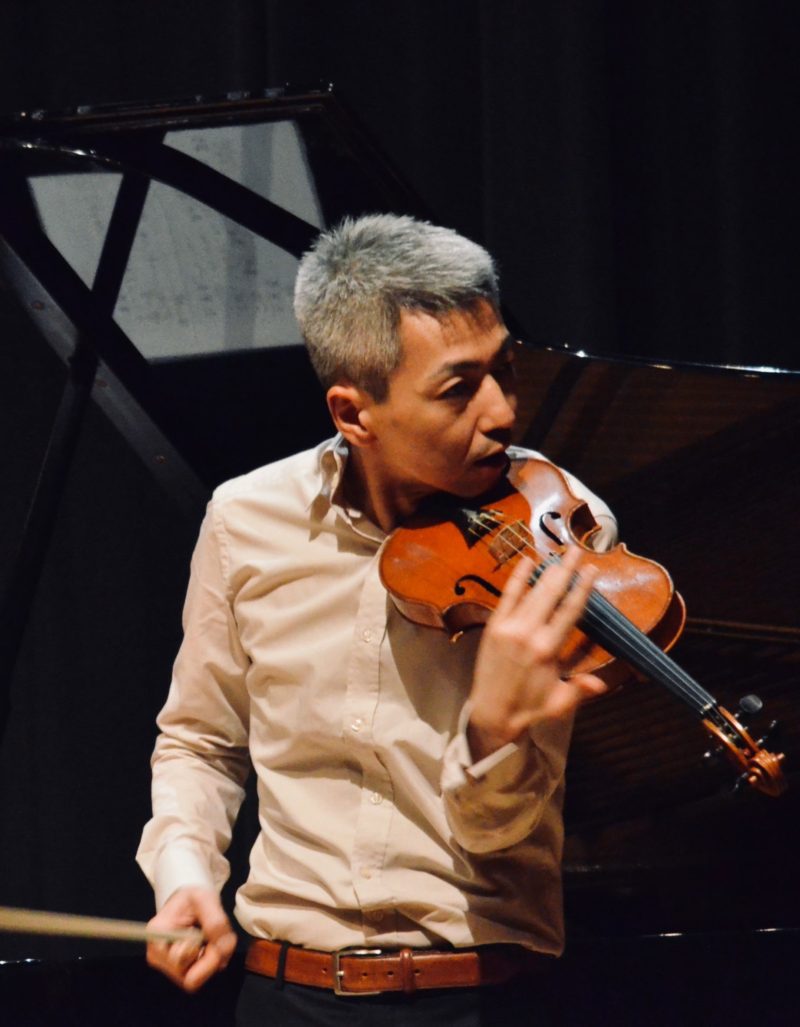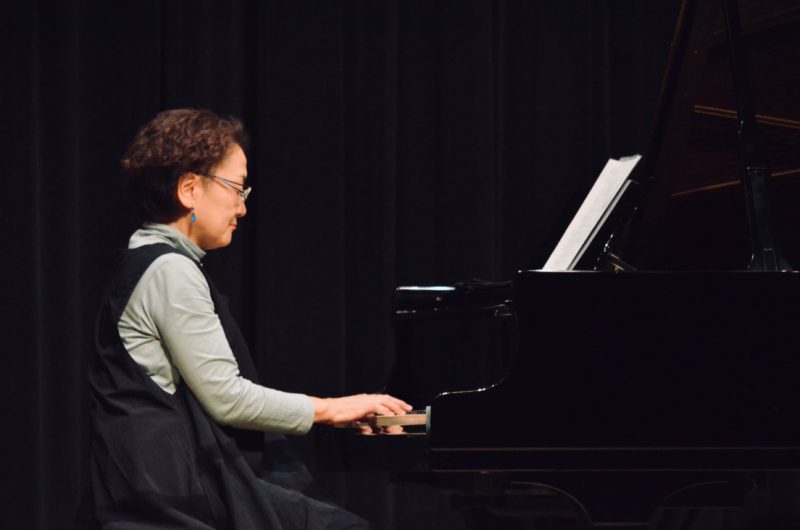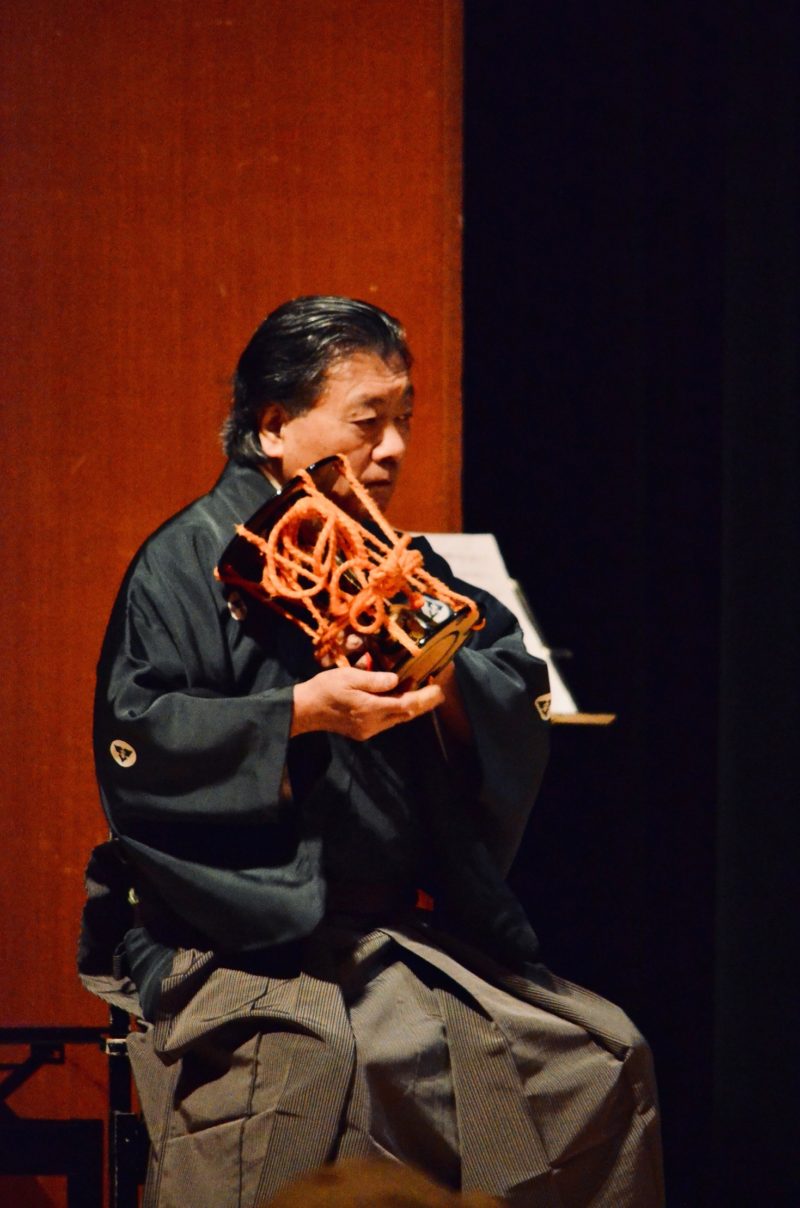#1045『Off/String(喜多直毅/セバスチャン・グラムス/ハラルド・キミッヒ)+黒田京子/久田舜一郎/松本泰子』 『Off/String (Naoki Kita/Sebastian Gramss/Harald Kimmig) featuring Kyoko Kuroda/Shunichiro Hisada/Taiko Matsumoto』
2018年11月14日(水)@ゲーテ・インスティテュート東京
Goethe Institut Tokyo, 14th November 2018
Reported by Kayo Fushiya 伏谷佳代
Photos by Etsuko Yamamoto, Keiko Kodaka 山本悦子 小高慶子
<出演/performances>
“Off/String”;
喜多直毅 Naoki Kita (violin)
セバスチャン・グラムス Sebastian Gramss (contrabass)
ハラルド・キミッヒ Harald Kimmig (violin)
ゲスト Guests;
黒田京子 Kyoko Kuroda (piano)
久田舜一郎 Shunichiro Hisada (Kotsuzumi-Utai)
松本泰子 Taiko Matsumoto (vocal)
ケルン・シーンを代表するコントラバス奏者セバスチャン・グラムスと即興アーティストとして異才を放つハラルド・キミッヒ(ヴァイオリン)を喜多直毅が招聘、三弦によるトリオ『Off/String』として日本をツアーした千秋楽。様々な編成により各地で公演したが、この日は喜多とゆかりの深い3人のヴェテラン音楽家—黒田京子(ピアノ)、久田舜一郎(小鼓)、松本泰子(ヴォーカル)—が加わった。
これだけの辣腕揃いになると、言うまでもなく個々の音楽が完成した小宇宙をもつ。自然発生的ながら、張り詰めたテンションはいかなる時も健在。自らを知り抜いていることが他者への自然な配慮となって現れる。融和し、拮抗し、促し、時に出し抜く、究極のアンサンブル。包容力に満ちるが、無駄やたるみが一切ない。
第一部は、数分から10分程度の完全即興が形を変えながらつづく。以下は各シーンのスケッチである。
*第1即興 (久田・キミッヒ・グラムス・喜多・黒田)
音は「放たれる」ことなく、コントロールから逃れない。各々が生み出す振動と吸着のバランス。ピアノや弦とのノイズと呼応するパーカッシヴな小鼓、メロディアスな弦と親和する揺(うたい)で、久田の存在が大きく分岐する。
*第2即興 (久田・喜多・黒田)
「掬いあげられる」音たち。ピアノの内部奏法をはじめ、重力に逆らう様々なアプローチによって強調される、楽器の「隠された声」を掬い取ろうと聴き手の耳はそばだてられる。張り詰める表層の琴線はしかしながら豊かで、えぐるように拡張される柔と剛。小鼓は次第にノイズ化し、ヴァイオリンに絡めとられて太いうねりとなる。
*第3即興 (久田・キミッヒ・グラムス)
コントラバスとヴァイオリンによって「歌伴」される揺。暖かな通奏低音のように全体のトーンを決めてゆくグラムス。三位一体のようにみえて3体の音の属性がすべて異なるのが面白い。金属音を発するヴァイオリン、コントラバスの巨体の奥底から突如現れるメロディ。粘着質でアーシーなドライヴ感。
*第4即興 (キミッヒ・グラムス・喜多・黒田)
黒田によるドイツ語の掛け声が呼び水となり、軽妙に重ねられてゆくダンサブルなチェンバー・ミュージック。ステージ向かって右脇を固める黒田と喜多はさすがの阿吽の呼吸。ノイズから濃密なメロディまで、2体のヴァイオリンによる拡張と収縮を受け止める黒田のピアノは、表層は多弁な丁々発止をみせつつも、背後に沈黙の深淵を覗かせる。その虚空が捉えどころがなく怖しい。多彩な音色が大きな魅力の奏者ながら、あえて色彩を抑えつつ、パーカッシヴなプレイを含めた響きの立体性で見通しのよい音楽。
*第5即興 (久田・キミッヒ・グラムス・喜多・黒田)
久田のソロからスタートし、揺にシンクロしていく”Off/String”の三弦。コントラバスによるストロークの効いた指弾きのリフが、音楽を体幹から揺さぶる。それぞれが大きく伸吟する大団円は、ノイズも有機的に縫合されてゆく。
第二部は、本プロジェクトの立役者であった齋藤徹が、現代詩に曲をつけたという楽曲も含む4曲。ヴォーカルに松本泰子が参入。
そもそもユニット名である『Off/String』が示唆するのは、身体と(弦)楽器との接点であろうが、喜多・グラムス・キミッヒの3人が織りなす身体拡張的な器楽演奏では、その境目は攪乱される。キミッヒの限りなくダンスに近いパフォーマンスから幕開け。ヴァイオリンを身体の一部と措定すれば、いかなるスポーティな瞬間でも身体の動きと並行して音が鳴り続けるのは道理といえる。捩り、寝そべり、ステップを踏んでも、身体にフィットするよう声を上げ続けるヴァイオリン。ヒトの身体ならぬ、楽器込みの生命のフォーム。音楽的推移としての身体の動き。第二部は曲ものだけあり、経験と確かな技巧に裏打ちされた高い表現力も際立った。まず特筆すべきは、松本のヴォイスがもつマットな冷感。黒田のピアノの透明感と近似値をとりつつ絶妙な二層を成す。グラムスの編み出す多彩なテクスチュアはヴォイスとの絡みも抜群。3曲目の松本のスキャットとのデュオをはじめ、終曲ではヴォイスのリヴァーブをシームレスに引き継いだような瞬間もあり、息を呑んだ。当意即妙でウィットに富む、互いのシンクロと乖離のタイミングは、楽器の身体化があってこそ。細密な楽器間の対話の只中から突如堰(せき)を切ったように躍りでる、喜多のヴァイオリンの圧倒的なエレガンス。揺とは趣を異にする現代詩が乗ることで、改めて認識される小鼓と日本語の相性の良さ、風土に育まれた伝統。様々な時空を反転させ横断しつつ、「今」というかけがえのなさを高い精神性とユーモアでえぐり取ったステージ。日常と非日常を隔てる紙一重の薄膜を、彼らの身体は担う。(*文中敬称略。伏谷佳代)
Sebastian Gramss, representative figure from Cologne Jazz scene, and Harald Kimmig, conspicuous improviser and violinist, were invited to Japan by the prominent violinist, Naoki Kita and toured as a trio unit “Off/String”. At this closing concert of the tour, three experienced Japanese musicians who have a certain kinship with Kita—Kyoko Kuroda(piano), Shunichiro Hisada (kotsuzumi & utai), Taiko Matsumoto(vocal)—joined in the performance.
Needless to say, each and every one of them is outstanding figure in the field and has established strong musical view respectively. Their interplay is spontaneous, but never loose intensity of tension at any time. The fact that they thoroughly know their own music is emerged as tolerance to others. Harmonizing, counteracting, urging, and sometimes outwitting each other, ultimate forms of emsemble shows up. The music is full of generosity, but there is no slacking moment.
In the first part of the stage, full improvisational sessions continued changing formations (each set took a couple of minutes to circa ten minutes). Followings are my sketches of each set.
*1st improvisation (Hisada, Kimmig, Gramss, Kita, Kuroda)
Tones are not ‘released’, remained to be under the control of the players. Equilibrium between oscillation and absorption, plucking and bowing. Hisada’s existence branched off two directions; one was by his ‘kotsuzumi’ in response to percussive approaches of piano and noises of strings, another was by his ‘utai’(recitation in Noh) harmonized with melodious development of strings.
*2nd Improvisation (Hisada, Kita, Kuroda)
Tones ‘picked up’ by all possible means. Starting from inside piano, versatile ‘concealed voices’ against gravity of instruments never ceased to attract the ears of the audiences. However, tense surface of music kept the contradiction of amplitude; both flexible and solid textures were enlarged as if they were scooped out. Gradually “kotsuzumi” increased the degree of noise, was entwined with violin, and turned into together strong undulation.
*3rd Improvisation (Hisada, Kimmig, Gramss)
It was fresh to hear that ‘utai’, a traditional recitation in Noh theatre, was accompanied by contrabass and violin. The direction of musical flow was set by contrabass’s warm basso-continuo. Three instruments were perfectly harmonized like trinity, but the attribute of each usage was simultaneously emphasized; metallic texture generated by violin, melody unexpectedly appeared from the very bottom of the huge body of contrabass, etc. Overall, this session was brimmed with matt and earthy driving force.
*4th Improvisation (Kimmig, Grams, Kita, Kuroda)
Triggered by the count in German by Kuroda’s voice, a sequence of multi-layered fragments turned exhilarated chamber music before we noticed. Kuroda and Kita, who positioned on the right side from the auditorium, had a goof chemistry reflecting upon their long years’ collaboration. Kuroda’s piano functioning as a counterpart of expansion and shrink executed by two violins, showed flexible conversation on the surface, flashed at the same time huge abyss of the silence hidden behind—its nuanced emptiness was lyrical but shivering. Originally, one of the most distinctive features of Kuroda consists in her versatile colorful tones, but in this case, she dared to contain coloration and constructed a good perspective including her skillful percussive approaches.
*5th Improvisation (Hisada, Kimmig, Gramss, Kita, Kuroda)
Starting from solo play of Hisada, three strings (Kita, Kimmig, Gramss) merged respectively, synchronized with “utai”. Gramss’s riffs played with strong finger stroke moved the music to its foundation. In the climax, each instrument roared their dynamic voices, where even ‘noises’ were converged with organic consequences.
The second part was composed of four tunes including those of original organizer of this project, Tetsu Saito, who set contemporary poetries to music. From here, Taiko Matsumoto(vocal) came into the act.
To begin with, what the unit name “Off/ String” indicates should be the contact point between body and (string)instrument. Indeed, in the physically expansive performances by Kita, Gramss, and Kimmig, the border is blurred without limit. The dawn of the second part was set by Kimmig’s performance, that was almost equal to dance. If we predicate a violin as an extension of body, it is no wonder that a violin never stops producing sounds according to body movements at any strenuous moment: any acrobatic movement like twisting, lying down, stepping, does not prevent the violin vocalizing. Here, human body functions something like as a life form embracing the instrument within it; body movement and music draw the same trajectory as continuum. More than improvisation, playing composed tunes reveals musician’s player’s aspect vividly; expressive ability constructed on well-trained techniques. First impressed was Taiko Matsumoto, whose voice emits matt and cooling sensations; it was overlapped with transparency of piano keeping slight distance and formed exquisite two-layers. Diversified textures produced by Gramss were intertwined with changeable expressions of voice including scat singing in the third tune. In the last tune, there was a moment, in which reverb of a last syllable was taken over seamlessly by contrabass; it was breathtakingly superb. Quick-witted timing of mutual synchronization and dispersion is firstly realized after embodiment (integration to the body) of instruments. Overwhelming elegance of Kita‘s violin which suddenly springs out from the height of the close dialogues among instruments; compatibility of ‘kotsuzumi’ with Japanese language revealed by combining it with contemporary poetry; our cultural climate that fostered tradition. Reversing and traversing various time-spaces, their performance explored irreplaceability of “right now” with high spirit and humor. Their bodies assume the role of membrane, a fine-line between ordinary and extraordinary life. (Kayo Fushiya)
<関連リンク>
https://www.naoki-kita.com/
http://www.sebastiangramss.de/
http://haraldkimmig.de/
http://www.ortopera.com/
http://www.geocities.jp/syougetukai/profile.html
http://percussio8.wixsite.com/officetirta/taiko









